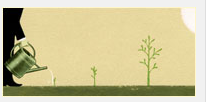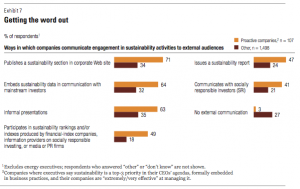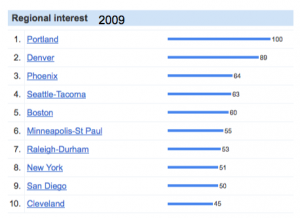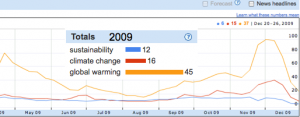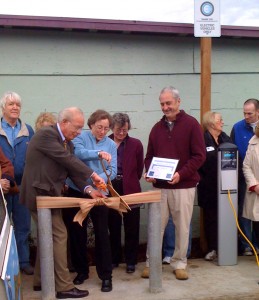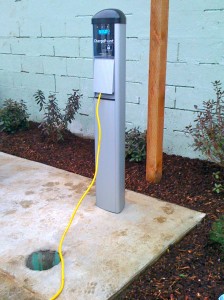 BP is buying keywords that enable them to run ads over the videos of many of our environmental and sustainability leaders.
BP is buying keywords that enable them to run ads over the videos of many of our environmental and sustainability leaders.
Category Archives: Uncategorized
Sustainability: Business leaders act on climate change
Ernst & Young report on climate change entitled, Action amid uncertainty, confirms customers expectations that the companies they do business with are acting on climate change and executives understand this as well as believing “they can make money, save money and manage risk.”
Excerpt:
While the responses indicate some variations across industry sectors and geographies, our survey reveals five consistent global themes:
- Executive leadership is critical to good governance
- Business drivers are dominated by top line and bottom-line impacts, creating a race to innovate
- Despite regulatory uncertainty, climate change investment is on the rise
- Execution is challenging but executives are committed to action
- Transparent reporting is gaining momentum
Sustainability: Searching and Not Finding
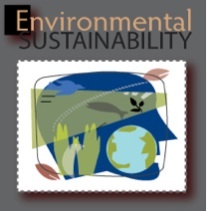 Over the last twelve months the phrases “environmental sustainability” and the “definition of sustainability” are in number 1 and 2 positions on the top Google searches for sustainability. What do searchers find and who influences their thinking? Most of our citizens are getting information on these terms from Wikipedia or the EPA or, in some cases, the more mainstream press such as MSNBC. Our site, EarthSayers.tv, is focused on being in the top results along with Wikipedia bringing the unfiltered voices of sustainability, a videopedia, if you will, calling out the people defining the emerging landscape of sustainability. We are not in the top rankings YET, but because we pay such close attention to search, we see a trend of major corporations moving into the top rankings as they come to understand how they can influence public perceptions of their “greenness” through paid and organic search strategies. Eventually the big Corporations will dominate the highest rankings.
Over the last twelve months the phrases “environmental sustainability” and the “definition of sustainability” are in number 1 and 2 positions on the top Google searches for sustainability. What do searchers find and who influences their thinking? Most of our citizens are getting information on these terms from Wikipedia or the EPA or, in some cases, the more mainstream press such as MSNBC. Our site, EarthSayers.tv, is focused on being in the top results along with Wikipedia bringing the unfiltered voices of sustainability, a videopedia, if you will, calling out the people defining the emerging landscape of sustainability. We are not in the top rankings YET, but because we pay such close attention to search, we see a trend of major corporations moving into the top rankings as they come to understand how they can influence public perceptions of their “greenness” through paid and organic search strategies. Eventually the big Corporations will dominate the highest rankings.
But getting the attention of progressives and their organizations on the importance of search and high rankings is difficult, largely because they lack any experience on the commercial side of the Web, resulting in much of the information and news produced around sustainability being buried in the back water of Google and Blinkx search results. A couple of years ago when we first started EarthSayers a search on Blinkx, a video search engine, netted 21,000 sustainability videos. Today it’s over 250,000!
So as the information chests GROW of the well meaning organizations and leaders, ranging from environmentalists to triple bottom line advocates, and the bloggers and twitterers, including our own @earthsayer, seed the Web organically, we aren’t really impacting the rankings on sustainability or on any of the related categories such as global warming and climate change. This is a failure contributing to the decline in awareness tracked in polls and surveys.
A recent Gallup poll cited in the Talk of the Town, The New Yorker, April 12, 2010, reports “forty-eight per cent of the respondents believe the threat of global warming to be generally exaggerated. This figure was up from thirty-five percent a year ago. According to the same poll, only fifty-two per cent of Americans believe that “most scientist believe that global warming is occurring – down from sixty-five per cent in 2008. The dark green line below represent the per cent of people (32%) who believe global warming is going to affect their lives, down from a high of 40 per cent.
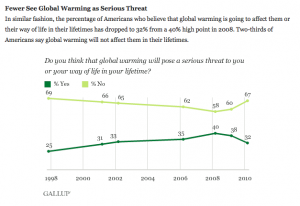 Elizabeth Kolbert in The New Yorker article also makes note of “a quarter of the TV weather-casters AGREE with the statement ‘global warming is a scam,’ and nearly two-thirds believe that, if warming is occurring, it is caused mostly by natural change.” This is painful to consider.
Elizabeth Kolbert in The New Yorker article also makes note of “a quarter of the TV weather-casters AGREE with the statement ‘global warming is a scam,’ and nearly two-thirds believe that, if warming is occurring, it is caused mostly by natural change.” This is painful to consider.
The Web as new media can play a critical role in educating our citizens about sustainability and the related issues, especially if we use it to bring to the fore with high page rankings the unfiltered voices of business and civic leaders, experts, consultants, and citizens from all walks of life. There is way too much processed information, particularly in the form of unsubstantiated marketing claims and green lists, and too little authentic voices of sustainability that can be found by searching the Web. Research shows that children rarely go beyond the first page of rankings and it is not a stretch to assume adults are not much different. We are working to fix the problem as soon as possible by educating leaders, aggregating sustainability videos, and using a sustainability taxonomy we created for our site to seed the Web methodically, but we can’t do it alone. We need help drawing attention to the problem that is, at the same time, a great opportunity to increase sustainability awareness and educate our citizens.
Note:
According to PEJ New Media Index “Global warming emerged as the second-largest story in the blogosphere (at 16%). It, too, has proven a favorite over the past year. Last week marked the 10th time that the subject has been among the top five stories on blogs since PEJ New Media Index began monitoring the blogosphere in January 2009.
Sustainability and Green Lists
In an earlier posting I talked about values washing kin to green washing and referenced the plethora of green lists out there to include Forbes’ Best Corporate Citizens, Most Ethical Companies, Newsweek Green Rankings (click for their green oil and gas company listings), and the Global 100 by Corporate Knights. I suggested that there is nothing better than these types of awards or lists to further confuse consumers and our citizens.
Research from the New Scientist showed that there is a huge gulf (their word) between perception and reality on the part of consumers.
I actually started this posting on EarthDay after receiving another list this time from Brandkeys, a consulting company specializing in customer loyalty. Their list in alphabetical order is of the 25 Top “Green” companies (see below). BP is on this list (but not on the ones above) and gave me pause even before the recent catastrophe. The press release notes that their research suggests consumers “want brands to walk-the-talk, and “green” has become the cost-of-entry in many categories, making larger and larger contributions to brand engagement and loyalty.” There are some excellent companies on this list including Seventh Generation and Tom’s of Maine in the consumer products category and the Marriott in the lodging industry. And many of these companies have strong sustainability initiatives backed up by a track record.
The problem is that this business of lists when it comes to the topic of green, the keyword for where sustainability and consumerism intersect, is the business of marketing, not sustainability and certainly not when it comes to environmental sustainability. In terms of marketing, it is my opinion that these lists mislead consumers, add to the confusion in the marketplace, and are based on unsubstantiated claims. The next question is what role do the CSR folks play in all this list making and is it responsible CSR?
Top-25 Green Brands from this year’s Brand Keys Loyalty Engagement Index:
1. American Express
2. Apple
3. Avon
4. BP
5. Coke
6. Coors
7. Dell
8. Ford
9. Honda
10. HP
11. Johnson & Johnson
12. Kellogg’s
13. Kohl’s
14. Marriott
15. McDonalds
16. Microsoft
17. Nike
18. Pepsi
19. Samsung
20. Seventh Generation
21. Staples
22. Starbucks
23. Tom’s of Maine
24. UPS
25. Wells Fargo
McKinsey Study on Managing Sustainability
This March McKinsey released an interesting Global Survey, “How companies manage sustainability.”
“Indeed 72% of respondents says considering sustainability is “extremely” or “very important” for managing corporate reputation and brands.”
The report covers the importance of sustainability being one of the top three priorities on the CEO’s list and energy companies might serve as a role model given they are closer to the dual issues of “potential regulation and increasing natural resource constraints.”
As to branding sustainability, in those cases where there is an authentic story and track record to back up claims, the marketer’s checklist ought to include getting the word out by publishing a sustainability section on the Corporate Website, embedding sustainability data in communication mainstream investors, issuing a sustainability report, communicating with socially responsible investors, and participating in rankings and indexing, although many of the lists these days are PR hokum. Here’s the chart showing these options with orange representing the more proactive companies. Download the PDF from this site.
Bottom line:
“Most companies are not actively managing sustainability, even though executives think it’s important to a variety of corporate activities. Those that do are reaping benefits for themselves and for society.”
Google Search, Part II.
In my recent post about Google search I cited the horse race on to own the search term sustainability using organic search and my experience with search results starting to vary based on my geo (Portland) and without me stipulating a geo search parameter. I cleaned by cache, google cookies and took my address information off Google profile and did this search today and nothing much changed. But then my friend, Barry, sent over an article from the March 2010 issue of Wired entitled Inside the Box. It’s all about Google search. And herein I read:
There is an opt-in feature that uses someone’s search history and location as a signals to determine what kind of results they’ll find useful. (This applies only to those who sign into Google before they search.)
I wonder where I opted-in? And I never notices whether I’m signed in or not. Will check on this.
ValuesTrashing?
New Scientist sponsored an “unparalleled quantitative assessment of companies’ global environmental impact” in conjunction with Earthsense of Syracuse, NY and Trucost, headquartered in London. They asked the question, “do the corporations that benefit from our environmentally conscious purchasing and investment choices deserve their green halo? If as consumers and investors we don’t have a good idea of what companies are “genuine” and authentic, it’s not likely we will move forward on rebuilding a greener, more sustainable economy.
I have referenced this study in an earlier blog post about values-washing, a sibling of greenwashing, where what companies tout as their values and what they actually do are two different stories, but did not note then the case referenced about Whole Foods in regards to the chasm between perception and reality. Whole Foods rated high on the consumer side, “shouting green,” but “Trucost’s modelling rated Whole Foods no better than conventional supermarkets such as Safeway. Part of the reason lies in the fact that Whole Foods has not disclosed all of the environmental data that Trucost needs in its rating system. Whole Foods promises “to produce a full inventory of its greenhouse gas emissions later this year.” But wait.
This last week friends brought to my attention a news story that Whole Foods is sourcing much of its private label brand (365 Organics) from China with the issue being “whether so-called ‘Organics’ are mislabeled with product packaging or labels that feature the Quality Assurance International (QAI) and United States Department of Agriculture (USDA) seals. This supposed transgression by Whole Foods was an ABC story and has been carried far and wide across the Internet. It appears, however, that Whole Foods is sourcing organic foods from China and the labels it afixes to its private label products is legit : “Since 2002, the USDA’s National Organic Standards have governed exactly what can be sold as organic in the US – how it’s grown, processed and handled – regardless of where in the world it’s grown, INCLUDING China.”
ValuesTrashing? It is getting increasingly difficult to know what to believe. The Web, however, is good for not only spreading mis-information but checking up on and ABC, as a source on the green movement, is interesting as they are owned by Disney, basically an entertainment company, “diversified international family entertainment and media enterprise with four business segments: media networks, parks and resorts, studio entertainment and consumer products. ABC apparently isn’t all that much in to fact checking these days, but then Whole Foods wasn’t upfront about its process and partners in the food chain. More transparency is called for.
Portland: the Most Sustainability Conscious U.S. City
Since 2004 the growth of the search term on sustainability has been slow and bumpy, but UP. And the state with the highest volume of search? Oregon with Vermont close behind and in 2009 close to closing the gap. And while Eugene outpaces Portland if you look at the period 2004 to the present, Portland outpaces all U.S. cities in 2009. Denver is close behind. It would be a good thing for the cities lagging behind to benefit from the expertise here in Portland from the leaders among all economic sectors. 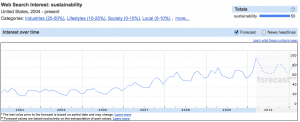 Starting from the bottom of the top ten, cities such as Philadelphia, Sacramento, San Diego, Minneapolis & St. Paul, Seattle-Tacoma, Raleigh-Durham, Boston, and Phoenix would benefit from a transfer of skills and expertise. This is part of the reason EarthSayers.tv has started the Portland Sustainability Leadership Channel (PSLC). We collect already available videos from around YouTube that feature Portland’s leaders. Aggregating the content increases the likelihood of finding Portland’s leader from among the YouTube sea. Its search function is extremely limited. The PSLC is then linked to EarthSayers.tv giving them national and international exposure. We twitter and tweet as well. Both YouTube (#4 on search volume) and twitter (no. 1 on fastest rising by 1250%) are heavily searched terms on Google and, as such, are busy places to reach an audience. While EarthSayers is new and growing, over the last two months there have been over 6,000 visits, with 2,000 of them being unique as visitors return 3x. We also create original content (thanks to filmmaker Barry Heidt) by interviewing leaders. The folks we have interviewed so far include Rob Bennett of the Portland Sustainability Institute, Marcelo Bonta of the Center for Diversity and the Environment, Dennis Wilde of Gerding Edlen Development Company, Mary Vogel, urban designer, of PlanGreen, Willem and Evan of Where Are Your Keys, Peter Bauer of Urban Scout Rewilidng, Lindsey Newkirk of Elysium Events, Kristy Alberty of the National Indian Child Welfare Association, Carl Grimm of Metro, and Kate Miller, consultant, sustainable Lighting.
Starting from the bottom of the top ten, cities such as Philadelphia, Sacramento, San Diego, Minneapolis & St. Paul, Seattle-Tacoma, Raleigh-Durham, Boston, and Phoenix would benefit from a transfer of skills and expertise. This is part of the reason EarthSayers.tv has started the Portland Sustainability Leadership Channel (PSLC). We collect already available videos from around YouTube that feature Portland’s leaders. Aggregating the content increases the likelihood of finding Portland’s leader from among the YouTube sea. Its search function is extremely limited. The PSLC is then linked to EarthSayers.tv giving them national and international exposure. We twitter and tweet as well. Both YouTube (#4 on search volume) and twitter (no. 1 on fastest rising by 1250%) are heavily searched terms on Google and, as such, are busy places to reach an audience. While EarthSayers is new and growing, over the last two months there have been over 6,000 visits, with 2,000 of them being unique as visitors return 3x. We also create original content (thanks to filmmaker Barry Heidt) by interviewing leaders. The folks we have interviewed so far include Rob Bennett of the Portland Sustainability Institute, Marcelo Bonta of the Center for Diversity and the Environment, Dennis Wilde of Gerding Edlen Development Company, Mary Vogel, urban designer, of PlanGreen, Willem and Evan of Where Are Your Keys, Peter Bauer of Urban Scout Rewilidng, Lindsey Newkirk of Elysium Events, Kristy Alberty of the National Indian Child Welfare Association, Carl Grimm of Metro, and Kate Miller, consultant, sustainable Lighting.
What other steps could be taken to promote Portland’s planning and urban design professionals, green building experts, and business owners who have worked hard at the business and civic levels and contributed to Portland’s sustainability reputation? They have helped Portland “turnaround” from the un-development following World War II that Michael Mehaffy has written left Portland “a hollow shell bisected by freeways, invaded by trendy but lifeless buildings and deserted by families heading for the suburbs.” Transformation was in order. Portland attracts people and jobs in a large part because of its sustainability reputation or brand. Now would be a good time to help the many consultants and professionals here in Portland export their skills and expertise to help other communities and in the process rebuild their own businesses clobbered by an economic collapse. We will continue to grow the Portland Sustainability Leadership Channel and seek support from the business community to fund our efforts (Chelsea Peil is the curator of the Channel and is extending invitations to companies with high integrity and a sustainability track record to be channel sponsors at a very modest rate for the branding- chelsea@earthsayers.com), but this is not enough. Let’s put our heads together and come up with more ideas for marketing the talent and brains of sustainability from right here in Portland.
Asset-based Collaboration for Sustainability
First, the “our and the us” of collaboration.
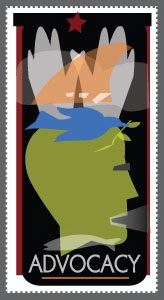 For us here at EarthSayers.tv the “our and the us” are the leaders of sustainability, the experts, teachers, business and civic leaders, citizens from all walks of life. It’s the organizations, old and new, in the sustainability movement encompassing the “isms” such as environmentalism; concepts such as biodiversity; principles such as permaculture, issues such as climate change, projects such as The War Room, and new technologies found in using our planet’s gifts with the conservation principles of reduce, reuse, and recycle. We call these leaders sustainability advocates and the organizations “for benefit,” building on the fledgling movement started by the Corp B people, searching for a common ground that drives prosperity, not just profits, a new sector of the economy.
For us here at EarthSayers.tv the “our and the us” are the leaders of sustainability, the experts, teachers, business and civic leaders, citizens from all walks of life. It’s the organizations, old and new, in the sustainability movement encompassing the “isms” such as environmentalism; concepts such as biodiversity; principles such as permaculture, issues such as climate change, projects such as The War Room, and new technologies found in using our planet’s gifts with the conservation principles of reduce, reuse, and recycle. We call these leaders sustainability advocates and the organizations “for benefit,” building on the fledgling movement started by the Corp B people, searching for a common ground that drives prosperity, not just profits, a new sector of the economy.
It’s not about the money.
When we approach for benefit organizations we believe we have something useful to you and you have something useful to us. And it’s not money. That’s been sucked out of the system so efficiently no government, business or non-profit can figure out where it went or if it will ever come back. No one seems to know where the end of the nozzle is and who has their hands on it. Right now it isn’t pointed in our direction that’s for sure. But if there is some money left on the table, we need to share it using cooperative revenue models.
It’s about our assets.
People
On our part, one of our assets, and the most important one, is our people. Yours too. We can do things you can’t and vice versa, and the proof for collaboration yielding more creative and useful solutions is indisputable. The commerce model of buyer and seller is competitive in nature, so let’s call what we do partnerships and stress collaboration among our people and your people.
Online and YouToo.
Another asset is our Websites that reach out into the World and, if we all cooperated, would be linked to one another, creating higher rankings, a bigger reach, more followers, more investors for all of us. What drives our Web development is open sourced, flexible, leverage-prone, and the source of connecting with the world, including the monied nozzle handlers. It’s a Web not a city center block of discrete buildings, where what we share is hidden underground, and the power is in private ownership and profits at all costs.
The Crowd
The third is our contacts, stakeholders, shareholders, colleagues, clients, members, and friends. How would they benefit from our working together? And would they find the benefit useful enough to return to us financial resources for the sustainability of our organizations to continue with our work? The only way to know the answer to this is work together on strategic initiatives, get feedback, learn from our efforts.
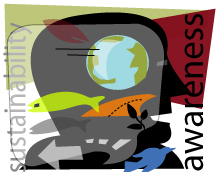 Reputation and Innovation
Reputation and Innovation
Fourth is reputation and innovation. Why do I put these two together? Well, typically, innovation doesn’t have a track record, it’s a solution to a problem, a new “brand” and hopefully an original one that solves a big problem. Without a track record. reputation must be earned and cannot be compromised early on by large sums of money or questionable affiliations so the innovative folks need a reputable partner(s). Get my drift. We may have the innovation, you the reputation or vice versa, but we need each other.
Secondly, the process of asset-based collaboration
Ed Morrison and his team at I-Open.org are innovators in civic engagement. They design and deliver engaging civic forums that encourage citizens to engage in conversation about complex topics, while building stronger civic networks. These forums point toward action: translating ideas into transformative initiatives. The basis of this action is a process Ed calls Strategic Doing. Central to strategic doing and to asset-based collaboration are four questions that lead towards a mutual goal ” to articulate a clear direction and then to define initiatives that align with this direction…Thick, trusted networks evolve that are strategic. They help us learn faster, make decision faster, and act faster.”
The four questions:
What could we do together? Exploring our assets to find new opportunities.
What should we do together? Focusing on one opportunity at a time and defining, clearly, the “strategic outcomes” we want.
What will we do together? Launching new initiatives by aligning our resources with “link and leverage” strategies.
What are we learning together? Learning what works by executing and measuring what happens.
Our job as leaders, Ed points out, is to “keep people focused and the process open…And leadership is a shared responsibility, distributed within the group.” A world view of asset-based collaboration using the discipline of strategic doing and beginning with the four questions is where we are at, come join with us.
About Ed Morrison
 Ed Morrison is founder of I-Open, the Institute for Open Economic Networks, based in Cleveland, Ohio and is a member of the staff of the Center for Regional Development at Purdue University and
Ed Morrison is founder of I-Open, the Institute for Open Economic Networks, based in Cleveland, Ohio and is a member of the staff of the Center for Regional Development at Purdue University and
Economic Policy Advisor for the WIRED initiative in North Central Indiana. Our thanks to Ed and his staff for their generous sharing of ideas and information and for the work they are doing in our economically challenged communities, especially my hometown, Cleveland, Ohio.
An Electric Charge and a Blast of the Past
Thanks to my colleague and film producer, Barry Heidt, I had the opportunity this week to attend the dedication of an electric car charging station in the beautiful beach town of Lincoln City, Oregon – my first look, believe it or not, at a charging station. Mayor Lori Hollingsworth and the City Manager, David Hawker cut the ribbon (jute these greener days) and took one step ahead in fighting global warming. The mayor in her remarks pointed out that “IF we want electric cars, you’ve got to put the infrastructure ahead of the cars. It is a chicken or the egg thing.” And electric cars are coming. Nissan is expecting delivery of 1000 electric vehicles to various Oregon dealers in the next year and as Jonathan Brinckman of The Oregonian reported last July, “while there are only about 400 all-electric vehicles registered in Oregon, the state estimates that within a decade, plug-in cars could account for about 20 percent of new vehicles sold in Oregon.” Go Green, Go Lincoln City and by visiting this beach town, you help support the leaders and citizens of the town who are acting responsibly in investing in eco-tourism and sustainable development. The Mayor recognizes what many sustainability advocates know: “The cumulative impact of many actions will make a difference in combating global warming.”
This is a good time to reference another filmmaker friend of mine, Paul Steinbroner who is producing a documentary (or two) on the electric car and has been following the inventor of the plug-in vehicle, Professor Plug In, aka Andrew Frank, Ph.D. for years. Read Paul’s blog and follow him on Twitter by visiting his site, Energyrush.tv.
Also newly discovered as they are following me on Twitter, @earthsayer, are the EVcast guys, Bo Bennett and Ryan Levesque host this very informative podcast about electric cars. You can follow them on Twitter as well @EVcast.
P.S. I had the good luck of spending the evening at The Historical Anchor Inn, one of four leadership designated lodgings of the Sea Star program in Lincoln City. What a place.
Kip Ward and his wife have created a magical environment by bringing back to life the past, our past, and word is if you don’t recycle you are not invited back. Give a listen to Kip address sustainability on EarthSayers.tv, the voices of sustainability.


